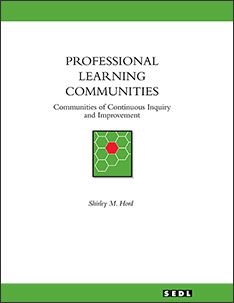Professional Learning Communities: Communities of Continuous Inquiry and Improvement
Preface
 Over the past several decades, both the public and education professionals have been vocal in their demands for new programs and practices in education. Simultaneously, these advocates have acknowledged that educators must come to an intimate understanding of the process of change in order for implementation to be successful and for the promises of new practices to be realized. During this period, an abundance of improvement processes were introduced to school practitioners in the hope that change would become less uncertain.
Over the past several decades, both the public and education professionals have been vocal in their demands for new programs and practices in education. Simultaneously, these advocates have acknowledged that educators must come to an intimate understanding of the process of change in order for implementation to be successful and for the promises of new practices to be realized. During this period, an abundance of improvement processes were introduced to school practitioners in the hope that change would become less uncertain.
For example, the effective schools research and its related school improvement process provided the foundation for many schools around the globe to think about and work on school change. Subsequently, many other models and programs designed to improve student performance were highly touted and marketed.
Because the literature on successful school change proclaimed the importance of the principal, the role and the actions of the principal in behalf of school improvement were widely studied and reported. Despite the time and resources devoted to the study of and attention to many other aspects of change in education, disappointment in the amount and extent of educational improvement has been widespread.
A quick-fix mentality, especially prevalent in U.S. culture, resulted in many schools being poorly prepared for their plans for change and therefore implementing change in a superficial and less-than-high-quality way. This approach might be called the "microwave oven" theory of school improvement: Pop a new program in for four minutes with a hero principal to manage it and improvement is done. What then?
Throughout my years of involvement in the school improvement process - as a participating faculty member in schools that sought increased benefits for students; as a student of school change and improvement, researching the factors that affect change; and as an external facilitator, supporting schools' efforts for improvement - I have seen many examples of unsuccessful change. Thus I began to wonder if there wasn't a better way to do things. During this time, I had the opportunity to work in a "learning organization" that matched Peter Senge's descriptions of such an organizational arrangement (1990). In that environment I experienced a nurturing culture that encouraged a high level of staff collaboration in the effort to understand successful change processes.
Subsequently, during a decade of valuable and productive research and development work at the Southwest Educational Development Laboratory (SEDL), I was privileged to study the improvement efforts of a school whose staff operated as a professional learning community. The school's working conditions paralleled my earlier experience with a learning organization. The results of the SEDL study revealed a new model of school culture and organization that actively supported educational change and improvement.
Those experiences stimulated my thinking about organizations that value change as a means of realizing increased effectiveness. In their research on improving the urban high school, Miles and Louis (Louis & Miles, 1990; Miles & Louis, 1990) cite "the will and the skill" for change. Much knowledge has been accrued regarding the skills necessary for change; what is not so clear is how to obtain the will - the motivation, the interest, the action - to do something with the knowledge that is available.
It seemed to me that if we could better understand the phenomenon of producing change-ready schools (those that value change and seek changes that will improve their schools), we could develop a more effective strategy for pursuing continuous school improvement. Jeannie Oakes, from her studies of school context, maintains: "There is evidence that a 'professional' staff will work toward implementing strategies and programs to improve results" (1989, p. 194).
With encouragement about such school-based professional structures, and with the need for increased understanding of these structures, this literature review was initiated. The review seeks (1) to define and describe what the literature is calling the professional learning community; (2) to describe what happens when a school staff studies, works, plans, and takes action collectively in behalf of increased learning for students; and (3) to reveal what is known about how to create such communities of professionals in schools.
Though not exhaustive, the review includes stories and reports of research, most of which are not available in their original form but are reported by the researchers in books and articles in popular educational journals. These sources are reasonably accessible to educational practitioners at all levels of the system: state departments of education, institutions of higher education, intermediate service agencies, district offices, and local campuses. It is this audience for whom the review is intended - in the hope that this information will challenge and inspire all of us to make our schools more effective environments for both student and staff learners.
Shirley M. Hord
1997
Next Page: Introduction

